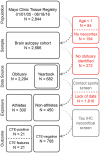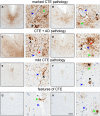Association between contact sports participation and chronic traumatic encephalopathy: a retrospective cohort study
- PMID: 31199537
- PMCID: PMC6916416
- DOI: 10.1111/bpa.12757
Association between contact sports participation and chronic traumatic encephalopathy: a retrospective cohort study
Abstract
Chronic traumatic encephalopathy is a debilitating neurodegenerative disorder associated with repetitive traumatic brain injuries often sustained through prior contact sport participation. The frequency of this disorder in a diverse population, including amateur athletes, is unknown. Primary historical obituary and yearbook records were queried for 2566 autopsy cases in the Mayo Clinic Tissue Registry resulting in identification of 300 former athletes and 450 non-athletes. In these cases, neocortical tissue was screened for tau pathology with immunohistochemistry, including pathology consistent with chronic traumatic encephalopathy, blinded to exposure or demographic information. Using research infrastructure of the Rochester Epidemiology Project, a comprehensive and established medical records-linkage system of care providers in southern Minnesota and western Wisconsin, medical diagnostic billing codes pertaining to head trauma, dementia, movement disorders, substance abuse disorders and psychiatric disorders were recorded for cases and controls in a blinded manner. A total of 42 individuals had pathology consistent with, or features of, chronic traumatic encephalopathy. It was more frequent in athletes compared to non-athletes (27 cases versus 15 cases) and was largely observed in men (except for one woman). For contact sports, American football had the highest frequency of chronic traumatic encephalopathy pathology (15% of cases) and an odds ratio of 2.62 (P-value = 0.005). Cases with chronic traumatic encephalopathy pathology had higher frequencies of antemortem clinical features of dementia, psychosis, movement disorders and alcohol abuse compared to cases without chronic traumatic encephalopathy pathology. Understanding the frequency of chronic traumatic encephalopathy pathology in a large autopsy cohort with diverse exposure backgrounds provides a baseline for future prospective studies assessing the epidemiology and public health impact of chronic traumatic encephalopathy and sports-related repetitive head trauma.
Keywords: chronic traumatic encephalopathy; contact sports; football; tau; traumatic brain injuries.
© 2019 The Authors. Brain Pathology published by John Wiley & Sons Ltd on behalf of International Society of Neuropathology.
Figures



References
-
- Darby A, Adams J, Babcock K, Alvarez V, Stein T, McKee A (2015) Detection of CTE in autopsy cohorts using restricted cortical sampling. J Neuropathol Exp Neurol 74:615.
-
- Hof PR, Knabe R, Bovier P, Bouras C (1991) Neuropathological observations in a case of autism presenting with self‐injury behavior. Acta Neuropathol 82:321–326. - PubMed
Publication types
MeSH terms
Substances
Grants and funding
LinkOut - more resources
Full Text Sources
Medical

